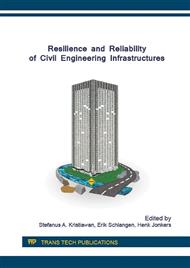p.70
p.76
p.83
p.89
p.94
p.100
p.106
p.113
p.119
Development of Graphical Method of Pile Group Foundation Design
Abstract:
In the construction projects, a pile group foundation is often utilized. The group of bored piles is usually installed relatively close to each other and joined at the top by a pile cap to hold up the loads. In other hand, a fast estimation of the groups of piles capacities are needed in the preliminary design and in other conditions of projects, such as a supervisor of projects want to estimate the capacities of the group of piles. The purpose of this research is to study the correlations of groups of piles efficiencies with the number of piles and to compare the groups of piles capacities with the single piles capacities. Furthermore, this study is aimed to make a fast estimation of groups of piles capacities using proposed graphical method.The piles efficiencies are calculated using several methods, such as Simplified Analysis, Converse-Labare [1][2], Los Angeles Group, Seiler - Keeney, Das, and Sayed - Baker. In order to calculate the groups of piles capacities, the capacities of single piles are needed. The singles piles capacities are taken from graphical method proposed by Djarwanti et al. (2015a and 2015b). Three graphical methods utilized are derived from the Briaud et al. (1985) , Reese and Wright (1977), and Reese O’Neill method. Moreover, the proposed graphical method is applied in the case study. The case study takes palace in Graha Indoland Condotel Inside Yogyakarta Construction Project.The pile efficiency graph is recommended for this research since the value of pile efficiency could be easily taken. The value of pile efficiency for Graha Indoland Condotel Inside using Simplified Analysis, Converse - Labare, Los Angeles Group, Seiler – Keeney, Das, and Sayed – Baker are 1,75; 0,89; 0,94; 0,99; 4,00; 1,56 respectively. Meanwhile the value of pile group capacity with the value of pile group efficiency more than 1, showed that the pile group capacity based on the efficiency is bigger than the one based on single down pattern.
Info:
Periodical:
Pages:
94-99
Citation:
Online since:
July 2016
Price:
Сopyright:
© 2016 Trans Tech Publications Ltd. All Rights Reserved
Share:
Citation:


